本文最后更新于:2024年5月10日 下午
缓存
缓存的概念:存在内存中的临时数据。将用户经常查询的数据放在缓存(内存)中,用户去查询数据就不用从磁盘上(关系型数据库数据文件)查询,从缓存中查询,从而提高查询效率,解决了高并发系统的性能问题。
好处:减少和数据库的交互次数,减少系统开销,提高系统效率。
常用对象:需要频繁查询且较少改变的对象
Mybatis缓存特性
mybatis 也提供了对缓存的支持, 分为一级缓存和二级缓存。
- 默认情况下,只有一级缓存开启。(SqlSession级别的缓存,也称为本地缓存)
- 二级缓存需要手动开启和配置,他是基于namespace级别的缓存。
- 为了提高扩展性,MyBatis定义了缓存接口Cache。我们可以通过实现Cache接口来自定义二级缓存
【注】狂神的视频只是简单介绍了一级二级缓存以及开启方法,我将其整理,在网上找了一些Mybatis缓存机制相关博客进行补充!
在Mybatis的jar包中,找到org.apache.ibatis可以看到cache目录下的文件
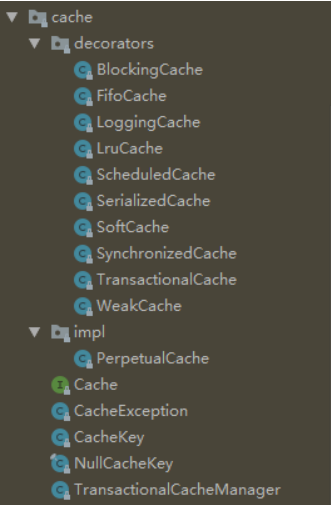
其中有一个Cache 接口,只有一个默认的实现类 PerpetualCache,它是用HashMap 实现的。
一级缓存
概念原理:
之前学习过:每当我们使用MyBatis开启一次和数据库的会话,Mybatis会创建出一个SqlSession对象表示一次数据库会话。一次会话中会有多次查询,其中可能就会有很多重复的,Mybatis处理的方法是什么呢?
答:MyBatis会在表示会话的SqlSession对象中建立一个缓存,将每次查询到的结果结果缓存起来,当下次查询的时候,如果判断先前有个完全一样的查询,会直接从缓存中直接将结果取出,返回给用户,不需要再进行一次数据库查询了。
SqlSession只是一个Mybatis对外的接口,SqlSession将它的工作交给了Executor执行器这个角色来完成,负责完成对数据库的各种操作。当创建了一个SqlSession对象时,Mybatis会为这个对象创建一个新的Executor执行器,而缓存信息就被维护在这个Executor执行器中,Mybatis将缓存和对缓存相关的操作封装成了Cache接口中。
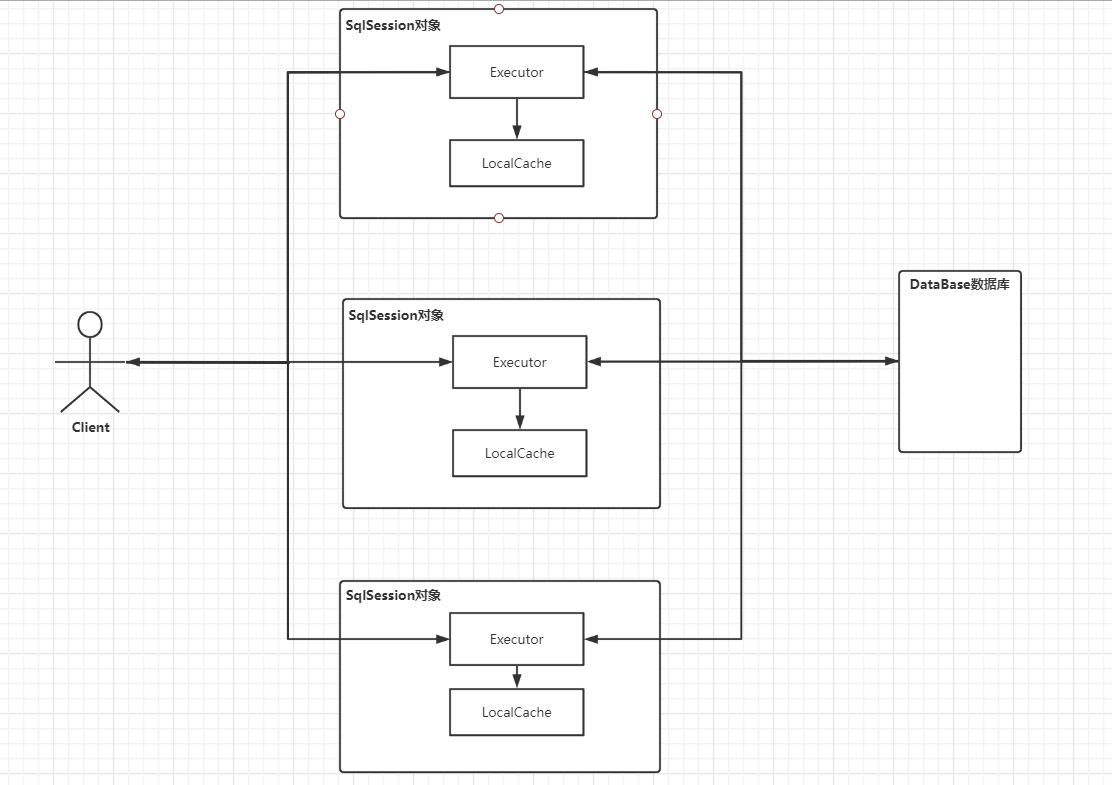
由于Session级别的一级缓存实际上就是使用PerpetualCache维护的,那么PerpetualCache是怎样实现的呢?
PerpetualCache实现原理其实很简单,其内部就是通过一个简单的HashMap来实现的,没有其他的任何限制。
这里作为Mybatis的入门,只是了解一下。
更多底层的执行步骤细节、源码实现,以后再专门去学习记录!
一级缓存的测试
编写接口方法
1
2
3
4
| public interface UserMapper {
User queryUserById( int id);
}
|
接口对应的Mapper文件
1
2
3
4
| <select id="queryUserById" resultType="com.liu9.pojo.User">
select * from mybatis.user
where id = #{id}
</select>
|
测试
1
2
3
4
5
6
7
8
9
10
11
12
13
| @Test
public void testQueryUserById(){
SqlSession session = MybatisUtils.getSession();
UserMapper mapper = session.getMapper(UserMapper.class);
User user = mapper.queryUserById(1);
System.out.println(user);
User user2 = mapper.queryUserById(1);
System.out.println(user2);
System.out.println(user==user2);
session.close();
}
|
可以看到:查询语句只执行了一次!并且判断user1==user2结果为true
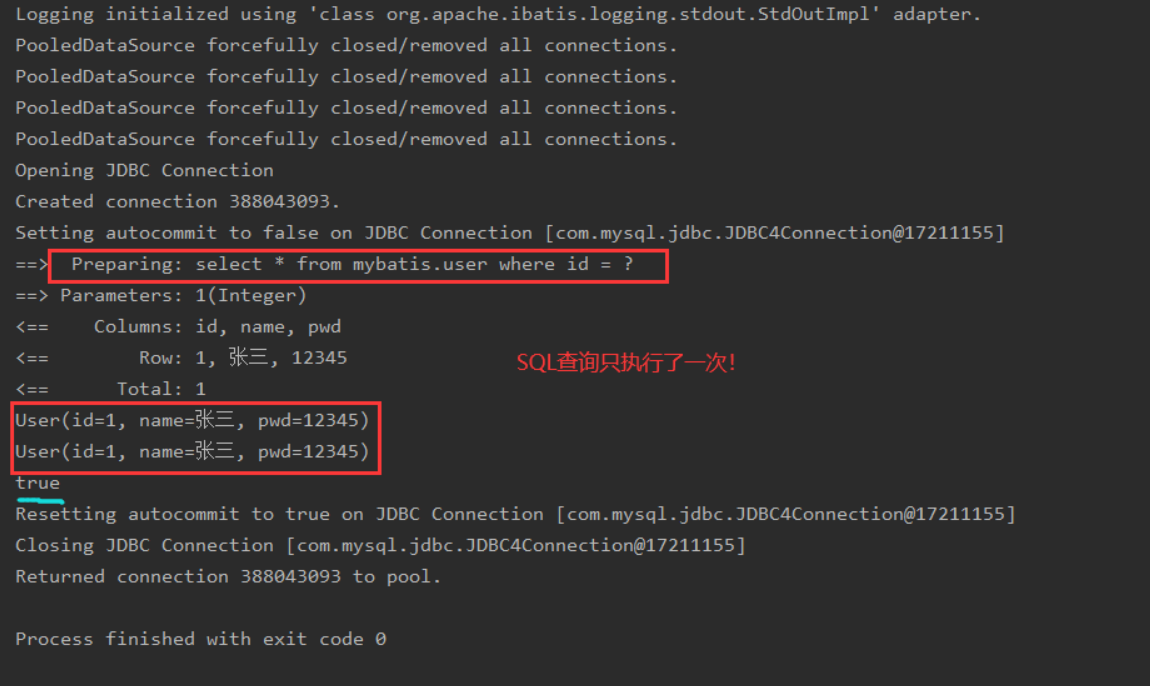
一级缓存生命周期
- 一级缓存是SqlSession级别的缓存,所以在SqlSession会话结束后,SqlSession对象及其内部的Executor和PerpetualCache对象都会一并释放掉
- SqlSession调用了close()方法时,会释放PerpetualCache对象
- SqlSession调用了clearCache()方法时,清空缓存,对象仍可用
- SqlSession调用了增删改等方法时,清空缓存,对象仍可用
以下是四种常见的SqlSession失效情况:
1、不同的SqlSession
1
2
3
4
5
6
7
8
9
10
11
12
13
14
15
16
17
18
19
| @Test
public void queryUserByIdTest(){
SqlSession sqlSession = MybatisUtils.getSession();
SqlSession sqlSession2 = MybatisUtils.getSession();
UserMapper mapper = sqlSession.getMapper(UserMapper.class);
User user1 = mapper.queryUserById(1);
System.out.println(user1);
System.out.println("<------------------------------------>");
sqlSession.close();
UserMapper mapper2 = sqlSession2.getMapper(UserMapper.class);
User user2 = mapper2.queryUserById(1);
System.out.println(user2);
System.out.println("<------------------------------------>");
System.out.println(user1==user2);
sqlSession2.close();
}
|
上面的代码开启了两个SqlSession,分别执行相同的查询,输出如下:可以看到它执行了两次SQL,表明user1的缓存并没有作用到user2上!结论:每个sqlSession中的缓存相互独立
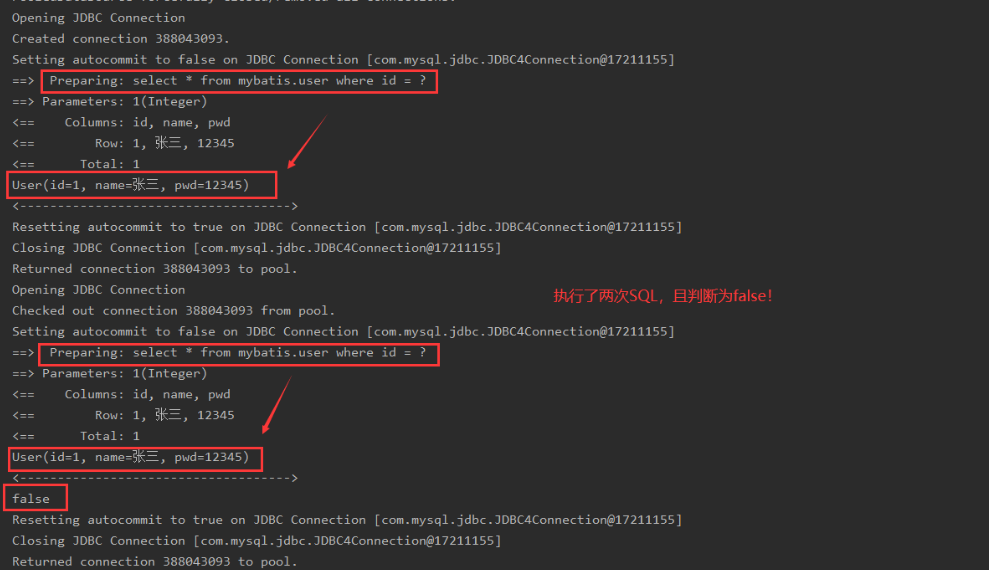
2、sqlSession相同,查询条件不同
1
2
3
4
5
6
7
8
9
10
11
12
13
14
| @Test
public void testQueryUserById(){
SqlSession session = MybatisUtils.getSession();
UserMapper mapper = session.getMapper(UserMapper.class);
UserMapper mapper2 = session.getMapper(UserMapper.class);
User user = mapper.queryUserById(1);
System.out.println(user);
User user2 = mapper2.queryUserById(2);
System.out.println(user2);
System.out.println(user==user2);
session.close();
}
|
这个很明显,user1和user2查询的对象并不相同,user1缓存的是queryUserById(1)内容,不能复用到user2上。同样观察结果发现两次查询,判断为false
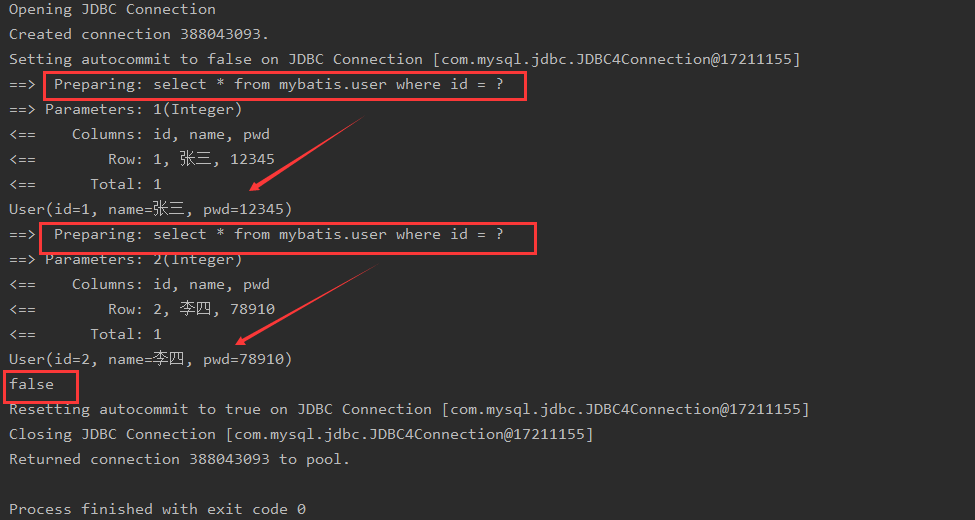
3、sqlSession相同,两次查询之间执行了增删改操作
增加方法updateUser
1
2
|
int updateUser(Map map);
|
配置对应的SQL语句
1
2
3
| <update id="updateUser" parameterType="map">
update user set name = #{name} where id = #{id}
</update>
|
编写测试代码:
1
2
3
4
5
6
7
8
9
10
11
12
13
14
15
16
17
18
19
20
| @Test
public void testQueryUserById3(){
SqlSession session = MybatisUtils.getSession();
UserMapper mapper = session.getMapper(UserMapper.class);
User user = mapper.queryUserById(1);
System.out.println(user);
HashMap map = new HashMap();
map.put("name","liuyi");
map.put("id",4);
mapper.updateUser(map);
User user2 = mapper.queryUserById(1);
System.out.println(user2);
System.out.println(user==user2);
session.close();
}
|
在两次查询中间加入了一个update操作
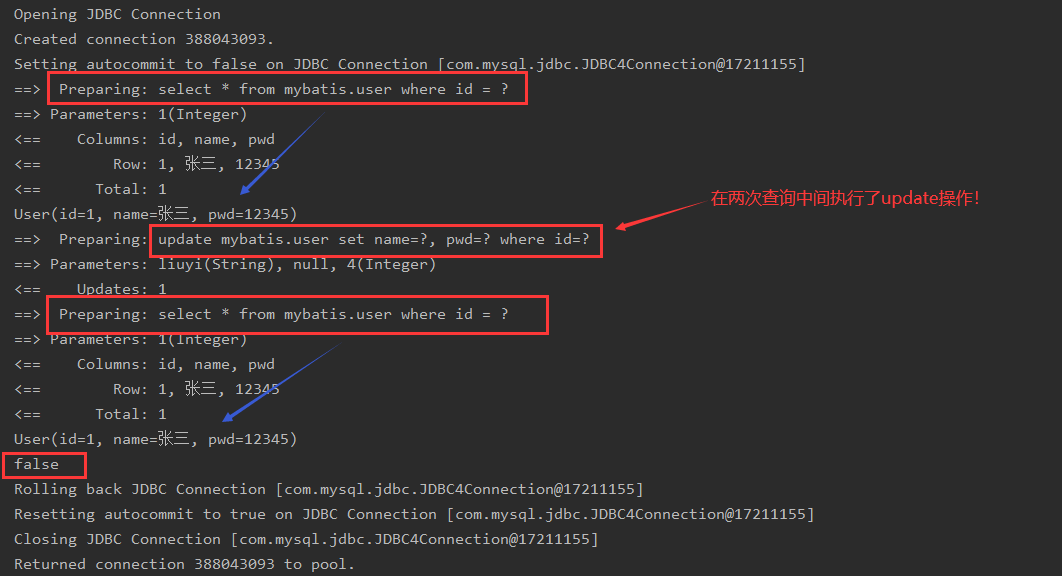
4、sqlSession相同,手动清除一级缓存
1
2
3
4
5
6
7
8
9
10
11
12
13
14
15
16
17
| @Test
public void testQueryUserById(){
SqlSession session = MybatisUtils.getSession();
UserMapper mapper = session.getMapper(UserMapper.class);
User user = mapper.queryUserById(1);
System.out.println(user);
session.clearCache();
User user2 = mapper.queryUserById(1);
System.out.println(user2);
System.out.println(user==user2);
session.close();
}
|
输出与上面一致,因为cache被手动清除了。
二级缓存
概念原理:
二级缓存是用来解决一级缓存不能跨会话共享的问题的,范围是namespace 级别的,可以被多个SqlSession 共享(只要是同一个接口里面的相同方法,都可以共享),生命周期和应用同步。如果你的MyBatis使用了二级缓存,并且你的Mapper和select语句也配置使用了二级缓存,那么在执行select查询的时候,MyBatis会先从二级缓存中取输入,其次才是一级缓存,即MyBatis查询数据的顺序是:二级缓存 —> 一级缓存 —> 数据库。
MyBatis 用了一个装饰器的类来维护,就是CachingExecutor。如果启用了二级缓存,MyBatis 在创建Executor 对象的时候会对Executor 进行装饰。CachingExecutor 对于查询请求,会判断二级缓存是否有缓存结果,如果有就直接返回,如果没有委派交给真正的查询器Executor 实现类,比如SimpleExecutor 来执行查询,再走到一级缓存的流程。最后会把结果缓存起来,并且返回给用户。
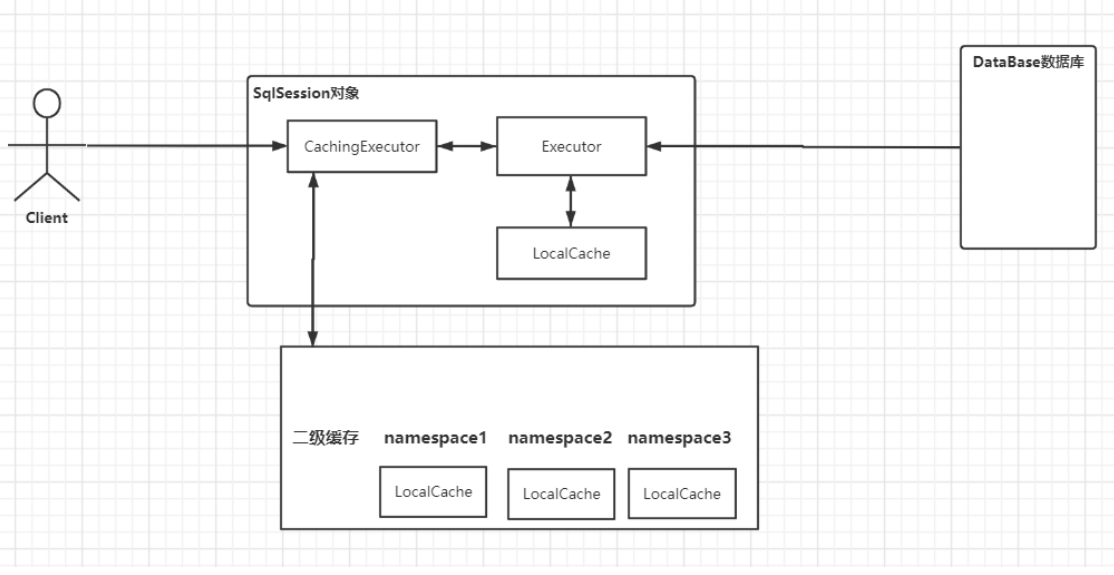
开启二级缓存
开启二级缓存可以参考官方文档,里面有介绍。
1、开启全局缓存 【mybatis-config.xml】
1
2
|
<setting name="cacheEnabled" value="true"/>
|
2、去每个mapper.xml中配置使用二级缓存,这个配置非常简单;【xxxMapper.xml】
1
2
3
4
5
6
7
8
| <cache/>
官方示例=====>查看官方文档
<cache
eviction="FIFO"
flushInterval="60000"
size="512"
readOnly="true"/>
这个更高级的配置创建了一个 FIFO 缓存,每隔 60 秒刷新,最多可以存储结果对象或列表的 512 个引用,而且返回的对象被认为是只读的,因此对它们进行修改可能会在不同线程中的调用者产生冲突。
|
3、代码测试
1
2
3
4
5
6
7
8
9
10
11
12
13
14
15
16
17
18
| @Test
public void testQueryUserById(){
SqlSession session = MybatisUtils.getSession();
SqlSession session2 = MybatisUtils.getSession();
UserMapper mapper = session.getMapper(UserMapper.class);
UserMapper mapper2 = session2.getMapper(UserMapper.class);
User user = mapper.queryUserById(1);
System.out.println(user);
session.close();
User user2 = mapper2.queryUserById(1);
System.out.println(user2);
System.out.println(user==user2);
session2.close();
}
|
结果成功,类似上面。
只要开启了二级缓存,我们在同一个Mapper中的查询,可以在二级缓存中拿到数据;查出的数据都会被默认先放在一级缓存中;只有会话提交或者关闭以后,一级缓存中的数据才会转到二级缓存中
缓存原理图
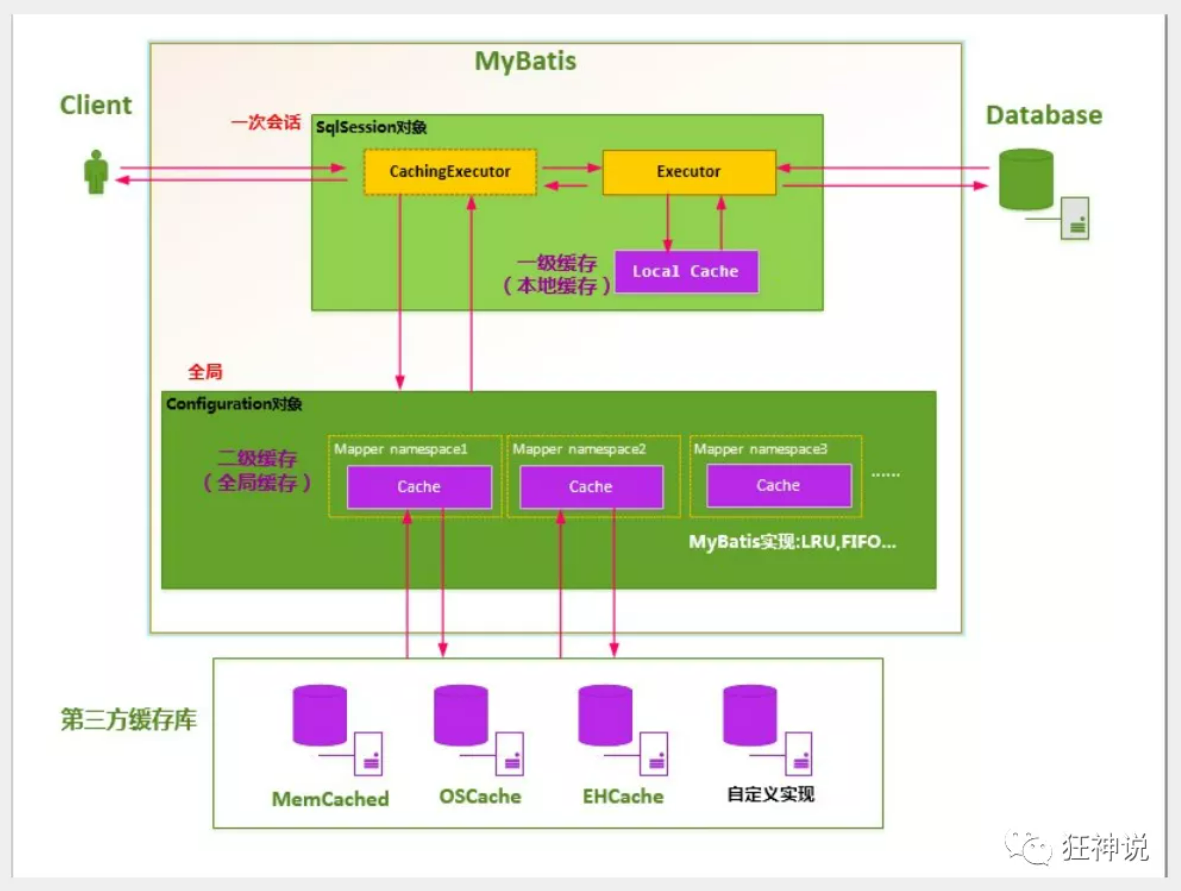
第三方缓存EhCache
MyBatis定义了缓存接口Cache。我们可以通过实现Cache接口来自定义二级缓存。以比较知名的EhCache为例:Ehcache是一种广泛使用的java分布式缓存,用于通用缓存;
要在应用程序中使用Ehcache,需要引入依赖的jar包
1
2
3
4
5
6
|
<dependency>
<groupId>org.mybatis.caches</groupId>
<artifactId>mybatis-ehcache</artifactId>
<version>1.1.0</version>
</dependency>
|
在mapper文件中写入
1
2
3
4
5
6
7
|
<cache
eviction="FIFO"
flushInterval="60000"
size="512"
readOnly="true"/>
<cache type="org.mybatis.caches.ehcache.EhcacheCache"/>
|
编写ehcache.xml文件,如果在加载时未找到/ehcache.xml资源或出现问题,则将使用默认配置。
【注】:详细的配置可以自行百度了解
参考







